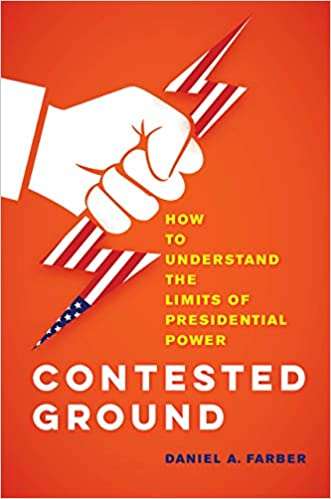The Volokh Conspiracy
Mostly law professors | Sometimes contrarian | Often libertarian | Always independent
Taking a Fresh Look at Presidential Power
Political polarization inevitably warps our views of presidential actions, making an even-handed approach all the more crucial.
Americans may be polarized today as never before in the past century. Battles over presidential power, however, are nothing new. Many Americans, not just in the South but also in the North, denounced Abraham Lincoln as a dictator wielding unconstitutional authority. Over the past forty years, Presidents Ronald Reagan, George W. Bush, Barrack Obama, and Donald Trump stand out as lightning rods for claims of unconstitutional usurpation of power. Two Presidents during those four decades were impeached by the House of Representatives, though they both escaped conviction in the Senate.
My new book, Contested Ground, tries to explore these issues while sidestepping ideological divides as much as possible. Just like virtually everyone else in America, I have strong views about Trump and other recent Presidents. There's a powerful temptation to celebrate presidential powers when exercised by the Presidents we admire, forgetting that those powers can also be used badly by other Presidents. I felt this temptation when writing a book about Lincoln and the Constitution. I constantly had to remind myself that other Presidents had used those same powers with less judgment and compassion, and sometimes toward bad ends. It may seem obvious, but it's important to keep reminding ourselves of a basic principle: The rules must be the same for the Presidents we admire as for the Presidents we detest.
A corollary of that principle is that we have to constantly keep in mind the need for presidential power and the risk of its abuse. Presidential powers can provide sorely needed national leadership, especially in times of crisis. Those powers also come at a price. Centralizing control of the executive branch in the White House can lead to more coherent, decisive federal policies. Centralized power also allows Presidents to force the executive branch into actions that may be unconstitutional or violate a federal statute. A President may act for personal gain or to reward campaign contributors. Giving the President broad authority over foreign policy and the military can be crucial in a dangerous world, but it creates dangers of its own if those powers are misused.
These may seem like platitudes. But given the current state of public debate in the United States, these aren't principles we can afford to take for granted. Indeed, standing up for these principles in the public square can draw heavy fire from all sides.
To make sense of the contending positions, I have found it helpful to think in terms of two contesting models of presidential power. We can point to fairly large areas where Presidents are free to act and others that seem off-limits. But the boundaries are constantly contested.
The contesting viewpoints have crystalized into two competing constitutional visions, which have made an appearance in almost every chapter of this book. One model of the presidency seeks to define a clear field for presidential action with little or no restraint from Congress or the courts. This presidentialist model of government has been championed by Presidents, their lawyers, and some judges. It seeks clearly separated powers, with a high wall surrounding each of the branches. The Vesting Clause is the central focus of this theory. The other model gives Presidents considerable power but envisions strong checks and balances to keep that power under control. This model of balanced government has had support from advocates of congressional power, civil libertarians, and quite often the Supreme Court.
In laying out two models of presidential power, I don't mean to imply that scholars, judges, or even Presidents fall neatly into two camps. These are complex issues, and the views held by an individual may incorporate elements of both models. But the two models provide the focal points around which the debates are organized. In theory, there could be a third model based on congressional supremacy, akin to the Whig vision of the presidency in the early 1800s. That model, however, has long been in eclipse.
I have my own views about the constitutional limits of presidential power, which I don't try to conceal in the book. But as the title indicates, the book is less about resolving the issues and more about "teaching the conflict." I also have my own views about how to interpret the Constitution. I'm not an originalist, but I try to present the historical evidence in a way that allows originalist readers to draw their own conclusions. By and large, these are not issues where one's stance on originalism is outcome determinative. One reason is that the presidency didn't receive nearly as much attention during the drafting and ratification of the Constitution as issues of federalism and congressional power. Originalists are hotly divided on many of the issues of presidential power, and so are non-originalists.
I'm very grateful for the opportunity to talk about the book with this audience. In my next posts, I'll try to explain my views on some of the most heavily contested issues of presidential power, including presidential removal power, the nondelegation debate, presidential war powers, and impeachment. I hope you'll stay tuned to hear more.



Show Comments (33)